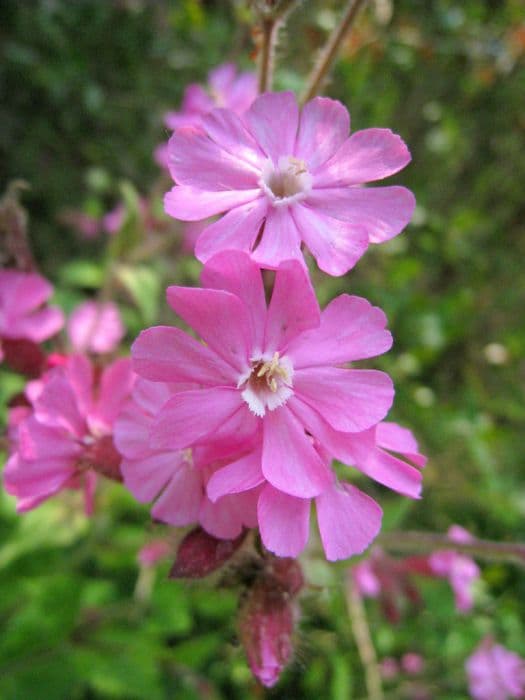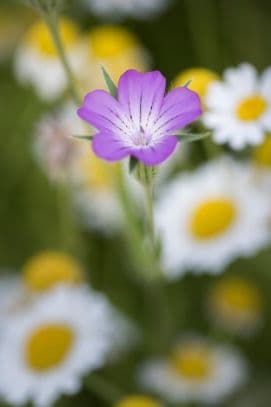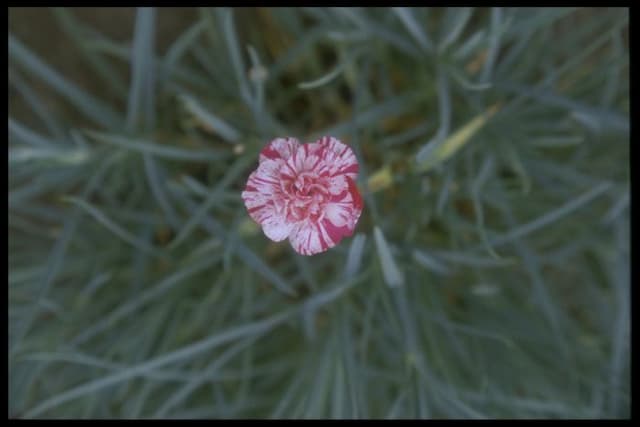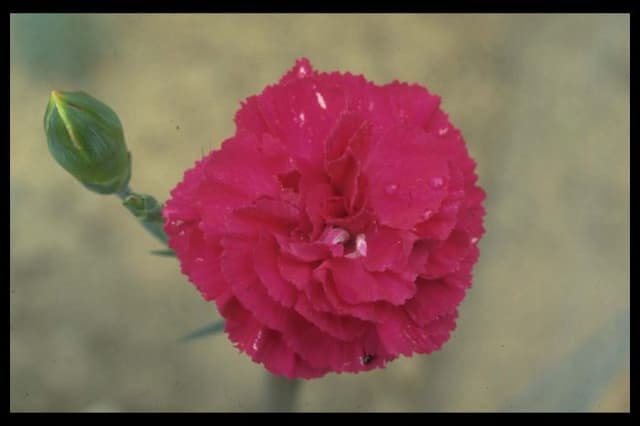Catchfly Lychnis viscaria

ABOUT
The plant commonly known as sticky catchfly or clammy campion displays a clump-forming habit with a basal rosette of narrow, lance-shaped, green leaves. As it matures, the plant sends up erect stems that are sticky to the touch due to the presence of glandular hairs, which is characteristic of this species and the source of its common names. The foliage may sometimes take on a grey-green hue, providing a nice contrast with the flowers. The sticky catchfly is admired for its beautiful flowers, which are borne in dense clusters at the top of the stems. These flowers are typically vibrant pink and boast five petals that are deeply notched, giving them a somewhat fringed look. Each flower blooms atop a long stalk, which enhances its visibility and attractiveness. The blossoms tend to open in the late spring to early summer, presenting a showy display that can last for several weeks. The striking flowers are not only visually appealing but also serve as a draw for a variety of pollinators, including bees and butterflies. The sticky catchfly's charming appearance makes it a popular choice for gardeners looking to add a pop of color to rock gardens, borders, or wildflower meadows. The plant's sticky stems also serve a functional purpose, potentially trapping small insects that attempt to climb them, though this is not its primary means of pest control.
About this plant
 Names
NamesFamily
Caryophyllaceae
Synonyms
Clammy Campion, Catchfly, Sticky Catchfly, German Catchfly
Common names
Viscaria vulgaris, Lychnis viscaria var. atropurpurea, Lychnis viscaria var. haematodes, Silene viscaria.
 Toxicity
ToxicityTo humans
The Lychnis viscaria, commonly known as Catchfly, is not widely known for its toxicity to humans. There is limited information available about its poisonous nature. However, as with many plants, it is generally advised to avoid ingesting parts of this plant because they can potentially cause gastrointestinal upset due to the presence of saponins and other compounds. If ingested, symptoms may include nausea, vomiting, diarrhea, and stomach pain. Always be cautious with children and pets around plants, and consult with poison control centers or seek medical attention if plant ingestion is suspected and symptoms appear.
To pets
Catchfly (Lychnis viscaria) is not specifically listed as toxic to pets, such as dogs and cats. However, the lack of detailed information means that the plant should be considered potentially harmful if ingested. As it can contain saponins and other irritating compounds, pets that consume parts of the Catchfly may experience mild gastrointestinal upset. Symptoms could include vomiting, diarrhea, and abdominal pain. It is always prudent to keep an eye on pets and prevent them from nibbling on plants that have not been confirmed as safe. If you suspect your pet has ingested parts of this plant and is showing symptoms, it is best to contact a veterinarian.
 Characteristics
CharacteristicsLife cycle
Perennials
Foliage type
Deciduous
Color of leaves
Green
Flower color
Pink
Height
1-2 feet (30-60 cm)
Spread
1 foot (30 cm)
Plant type
Herb
Hardiness zones
3
Native area
Europe
Benefits
 General Benefits
General Benefits- Ornamental Value: The Sticky Catchfly, with its attractive pink or purple flowers, adds visual appeal and color to gardens and landscapes.
- Attracts Beneficial Insects: It provides a nectar source for pollinators such as bees and butterflies, thus supporting local ecosystems.
- Drought Tolerance: Once established, it is tolerant of dry soil conditions, making it suitable for xeriscaping and low-water gardens.
- Ground Cover: Its dense growth habit can help suppress weeds and cover bare spots in the garden.
- Low Maintenance: Sticky Catchfly requires minimal care once established, making it ideal for gardeners seeking low-maintenance plants.
- Cold Hardy: It is capable of surviving and thriving in cooler climates, making it a versatile plant for various hardiness zones.
- Long Blooming Season: The plant has a lengthy flowering period which helps to provide extended interest and color in the garden.
 Medical Properties
Medical Properties- Adhesive properties: The sticky substance on the stem and calyx of Lychnis viscaria has been traditionally used to provide relief for small cuts and wounds by acting as a rudimentary adhesive.
- Astringent qualities: It contains tannins, which may have astringent effects, useful in tightening and toning tissues.
 Air-purifying Qualities
Air-purifying QualitiesThis plant is not specifically known for air purifying qualities.
 Other Uses
Other Uses- Lychnis viscaria, commonly known as the sticky catchfly, has been historically used in folk traditions to protect households from evil spirits when hung over the door.
- The sticky catchfly's adhesive stems can be used as a natural bird lime to trap small insects, which can then be fed to pet birds or studied for educational purposes.
- Gardeners sometimes plant sticky catchfly to create a visually appealing border in gardens due to its bright pink flowers and attractive foliage.
- The sap of sticky catchfly can be gently applied to papers as a rudimentary glue for crafts and scrapbooking, although it is not as effective as modern adhesives.
- Sticky catchfly can act as a natural indicator of soil conditions; it tends to flourish in calcium-rich soils, thus revealing soil quality.
- During textile production, the plant has been used to make a temporary bond when spinning wool, as its stickiness helps fibers adhere.
- Some gardeners use sticky catchfly as a deterrent for small mammal pests, due to the sticky nature of the plant's stem which animals avoid.
- In the language of flowers, sticky catchfly is sometimes used to symbolize an alluring charm, owing to its sticky nature and vibrant flowers.
- Enthusiasts of natural dyeing processes use the flowers of sticky catchfly to produce a light green dye for fabrics.
- Photographers and artists may use the aesthetic qualities of sticky catchfly, capturing its beauty in various forms of media and artwork.
Interesting Facts
 Feng Shui
Feng ShuiThe Catchfly is not used in Feng Shui practice.
 Zodiac Sign Compitability
Zodiac Sign CompitabilityThe Catchfly is not used in astrology practice.
 Plant Symbolism
Plant Symbolism- Steadfastness: Lychnis viscaria, commonly known as Catchfly, has sticky stems that trap small insects. This characteristic has been interpreted symbolically to represent steadfastness and an ability to hold onto things, be it relationships, beliefs, or one's goals.
- Protection: Since Catchfly can trap insects that might otherwise cause harm to the plant or nearby plants, it symbolizes protection against harm and negative influences.
- Attraction: The name 'Catchfly' also points to its ability to 'catch' or attract things, which can symbolize an allure or charisma that draws in good fortune, love, or success.
- Survival: Catchfly is a hardy plant that can thrive in different environments, representing the ability to survive and adapt to various challenges and conditions.
 Water
WaterSticky Catchfly, commonly known as Lychnis viscaria, prefers consistent moisture, especially during its growing season. Water thoroughly when the top inch of the soil feels dry to the touch. This could mean watering every week, but it's important to pay attention to the plant's environment and weather conditions, as they can affect the watering schedule. During hot, dry periods, you may need to water more frequently. Generally, providing about one to one and a half gallons per week should keep the Sticky Catchfly satisfied, depending on the size of the plant and the pot.
 Light
LightFor Sticky Catchfly, a spot with full sun to partial shade is ideal. It will thrive best with at least six hours of sunlight each day. Good light ensures healthy growth and optimal blooming. Be cautious of too much harsh midday sun if the plant is in an area that experiences extremely high temperatures, as this can sometimes stress the plant.
 Temperature
TemperatureSticky Catchfly does well in a range of temperatures but prefers moderate conditions. Temperatures between 60°F and 70°F are ideal for growth. The plant can survive minimum temperatures down to about 20°F, making it cold-hardy, but it will not fare well in temperatures exceeding 85°F.
 Pruning
PruningTo encourage optimal health and blooms, prune Sticky Catchfly after flowering to remove spent blooms. This deadheading process can stimulate a second flush of flowers. Cut back the foliage in the fall, as the plant goes dormant, to maintain a tidy appearance and prepare it for new growth in the spring. Pruning can be done annually, or as needed to remove dead or damaged stems.
 Cleaning
CleaningAs needed
 Soil
SoilCatchfly thrives in well-draining soil with a pH of 6.0 to 7.0; mix garden soil with compost and sand for optimal growth conditions.
 Repotting
RepottingCatchfly plants generally do not require frequent repotting; repot every 2-3 years or when the plant outgrows its container.
 Humidity & Misting
Humidity & MistingCatchfly prefers moderate humidity levels but is adaptable and doesn’t require any special humidity considerations.
 Suitable locations
Suitable locationsIndoor
Provide bright light and well-draining soil for Catchfly indoors.
Outdoor
Plant Catchfly in full sun to partial shade in well-draining soil.
Hardiness zone
3-8 USDA
 Life cycle
Life cycleLychnis viscaria, commonly known as Catchfly or Sticky Catchfly, begins its life as a seed that germinates when soil temperatures and moisture levels are adequate, typically in spring. Seedlings develop into rosettes with oblong leaves, experiencing vegetative growth throughout the first season. The plant enters a period of dormancy during the winter months, particularly in colder climates, conserving energy by dying back to the ground. In the following growing season, Catchfly produces flowering stems that range in height, topped with clusters of pink or crimson flowers from late spring into early summer. After pollination, typically by insects attracted to the sticky substance on the stems that gives the plant its name, the flowers develop into capsules containing small seeds. The mature seeds are dispersed, either naturally or by human intervention, completing the life cycle and allowing for new Catchfly plants to establish.
 Propogation
PropogationPropogation time
Spring-Early Summer
Propogation: Lychnis viscaria, commonly known as the sticky catchfly, is often propagated by seed. The best time to sow seeds is in early spring after the last frost when the soil is workable. Sowing the seeds can be done directly in the garden where they are to grow. The seeds should be scattered on the surface of well-draining soil and pressed lightly into the soil, without covering them as they require light to germinate. Consistent moisture should be maintained until germination, which usually occurs within 2 to 3 weeks. Sticky catchfly can also be propagated by dividing mature clumps in the spring or autumn, but seed sowing remains the most popular due to its simplicity and effectiveness.
![Pink [Cherry Daiquiri]](/_next/image?url=https%3A%2F%2Fplants-admin.emdemapps.com%2Fimages%2Fplants%2F%2Fimages%2F604b53704a83a.png&w=640&q=75)

![Pink [Passion]](/_next/image?url=https%3A%2F%2Fplants-admin.emdemapps.com%2Fimages%2Fplants%2F%2Fimages%2F604b53b9b9334.png&w=640&q=75)

![Pink [Silver Star]](/_next/image?url=https%3A%2F%2Fplants-admin.emdemapps.com%2Fimages%2Fplants%2F%2Fimages%2F604b61705f0a1.png&w=640&q=75)




